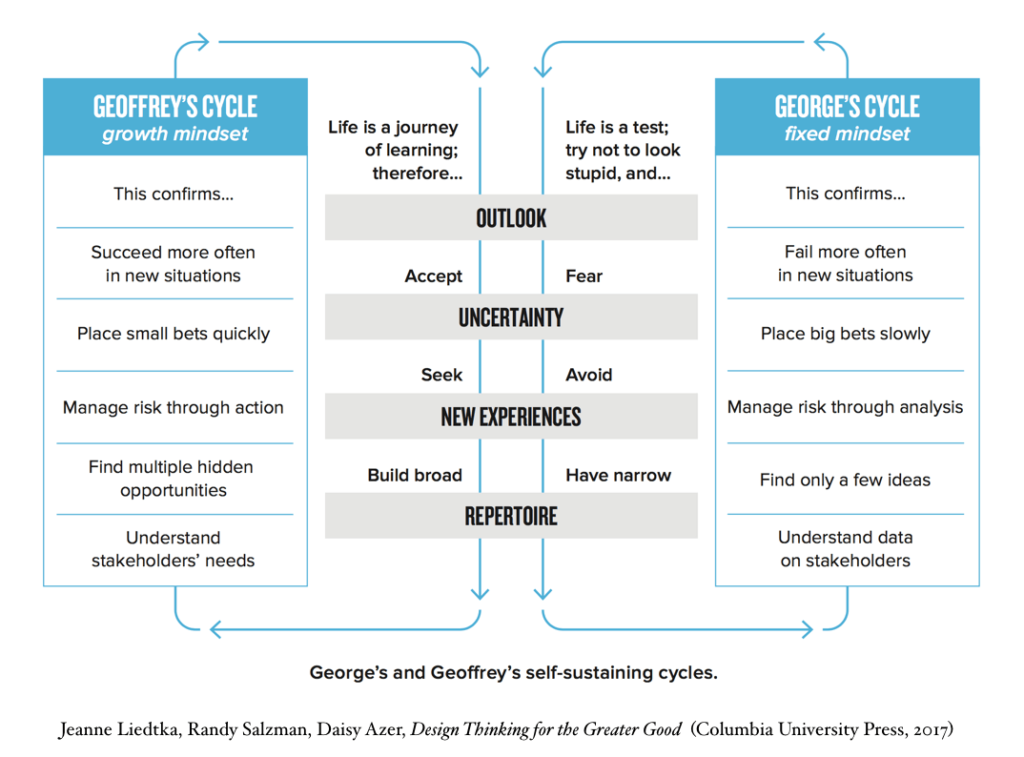Table of Contents
“The mind is everything. What you think you become.” – Buddha
What Lord Buddha said is not only truly applicable in general; In fact, it forms the crux of any Design Thinking process. Mindset is indispensable in any Design Thinking journey. While Design Thinking is widely appreciated to enable innovative outcomes (while solving a problem / coming up with a new product/service), we feel it is not possible without a correct mindset. In our 5-Step Process of Design Thinking© too, we focus on Preparing the Mindset as the basis. Let’s go deep into the same…
We all hail innovations but do we really ponder over what goes into the thought process of any innovator? Think of any innovative product or a service or a gadget or any other innovation which you appreciate; you will witness some of the below traits of mindset exhibited by the innovator (which would have been reflected in the outcome). These traits are fundamental to begin the journey of being a Design Thinker & cultivate them as habits or life-skills.
5 Key Mindset Traits in Design Thinking
User Centricity
Innovators not only focus on the problem of the users but also on the users who face the problem. Both are intertwined but often the user gets neglected in the urgency to solve the actual problem. Wearing the hat of user-centricity comes with a lot of practice because you need to unlearn about the user first and then re-learn. Real empathy comes by removing our own shoes (our bias, notions and judgments) first, before we put ourselves into the shoes of the users. This customer-centricity will help in garnering the unstated needs which when satisfied will lead to some meaningful innovation. Imagine about the first real smartphone. People needed to carry a camera (to take photos), an MP3 player (to hear songs), a diary (to take notes), a calculator (to do some calculations), a contact book (to save contacts), a map, maybe (to understanding routes) etc. A smartphone combined all these functionalities packed in one single device.

Interestingly, nobody complained about the burden of carrying so many devices. Smartphone-making companies understood this pain since they observed and felt the “vibes” (unstated needs) of the public at large. This wouldn’t have been possible without true Empathy and wearing a hat of User-Centricity.
Questioning the Status Quo / Assumptions
Why should loans be given only for purposes like education, home, establishing business? Why should someone who wishes to buy a car, be expected to pay the entire amount in lump sum? Today the question looks absurd but that was the reality a century back. Nobody questioned this assumption until Alfred Sloan (President of General Motors) formed “The General Motors Acceptance Corporation” in 1919 with an aim to provide customers with car loans. It became a big success as customers could buy a car without having to pay a lot of cash up front. GM questioned the status quo of lump sum payment and since then there was no looking back for the organization…. Take for example the space domain/exploration which was considered a government affair, until Elon Musk’s SpaceX designed Falcon 1 rocket was considered cheaper to operate and build, vis-à-vis competitors who were government-owned organizations. SpaceX questioned the assumption that private organizations can’t design and send rockets into the space.

Connecting the dots
One of the common traits that help in innovation is the innate ability to connect the dots. In connecting the dots, innovators try to take inspiration from different things and try to build any relevance with the problem they are solving. When we mean take inspiration, we mean from different sectors, different domains and importantly including Nature as well. Noted Author Maggie Macnab in her book “Design by Nature” tries to draw several analogies between the patterns that are exhibited in Nature and how human beings experience the same through the senses. She quotes several examples of how some of the esteemed organizations have designed their logos by seeing some patterns and anti-patterns that happen in Nature. To quote her “Words are the language of the head, but visuals carry the intuitive language of the heart.” Moving on to technology, the beak of the Kingfisher bird (because of its tapered shape that helps to break the air bubble) was inspirational for the engineering experts who designed one of the hi-speed Shinkansen bullet trains. The tapered shape helped for noise reduction.

Similarly, the legendary Henry Ford was amazed by the precise motions of carcasses in a typical large Chicago industrial slaughterhouse. He thought of introducing the concept of assembly line (structured movement of different car parts to be assembled in a planned manner) while manufacturing cars and then it changed the landscape of automobile manufacturing. And how can we forget our very own Aravind Eye Hospitals taking inspiration from McDonalds to design super-efficient operations and eye-related procedures.
Embracing vulnerabilities
Vulnerability is coming out of the comfort zone and trying something new. One of the traits of any innovator is to keep on trying till you succeed, as they call it “Fail Fast Fail Cheap” in entrepreneurial parlance. It literally means, in your efforts to create an innovative product and find its market fit (users), you need to be aware you can fail. Innovators are comfortable with the possibility of failure.
Growth Mindset
Noted American psychologist and professor at Stanford University Ms.Carol Dweck, whose work on “Growth Mindset” has been widely acclaimed; mentions the term as very critical, keeping in mind the development of a broader repertoire (developing different skills) and exploring vulnerabilities. According to Dweck, there are two kinds of mindsets viz. Fixed Mindset and a Growth Mindset. Whether a person qualifies for a Fixed or Growth depends on that individual’s behavior but more importantly on the individual’s reaction to failures.
Going deep into the Growth Mindset, noted Design Thinking practitioner Jeanne Liedtka and her colleagues in their book “Design Thinking for Greater Good” have highlighted the critical differences between these two mindsets with the help of two individuals.

To summarize, Design thinking application is a collaborative exercise which has 5-Step Process of Design Thinking© complemented with different Design Thinking tools; however without a correct Design Mindset, we won’t be able to generate impactful outcomes. That illustrates why mindset is the key in any Design Thinking process.
https://www.space.com/18853-spacex.html
https://www.britannica.com/topic/SpaceX
https://www.peachpit.com/articles/article.aspx?p=1755414
https://www.thoughtco.com/henry-ford-and-the-assembly-line-1779201
https://www.insightnews.com.au/how-mcdonalds-inspired-the-success-of-an-extraordinary-eye-hospital/
https://www.bloomberg.com/news/articles/2007-06-24/fail-fast-fail-cheap

